Taxonomy: Class: Mammalia; Order: Lagomorpha; Family: Leporidae
Description
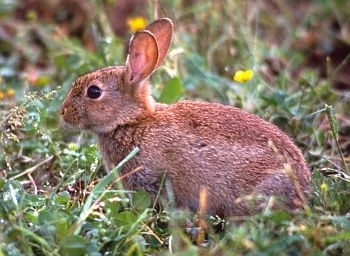
Rabbit © Alexis de la Serre
The rabbit is a small burrowing mammal that is herbivorous and active mainly at night. It rarely lives for more than three years. The rabbit was introduced to Britain by the Normans in the 12th century for its meat and fur. It has been bound up with man's activities ever since, experiencing a full change of status from a prized and protected commodity to a national pest because of the agricultural damage that it causes. The disease myxomatosis, which arrived in Britain in 1953,drastically reduced rabbit numbers until resistance developed (Ross & Tittensor 1986). A new disease, rabbit viral haemorrhagic disease, arrived in England in 1992 and reached Scotland in 1995 (Chasey & Trout 1995).
The rabbit can be shot or trapped throughout the year.
Further information:
Mammal Society website rabbit page.
Conservation status and legislation
Status:
UK: Non-native
World: Near Threatened (IUCN Red List)
Legislation:
Distribution and abundance
The rabbit is found throughout almost all of Britain, being absent only from the Isles of Scilly, Rhum, Tiree and some of the small Scottish islands. It is much more widespread in Ireland than the limited records visible on the map (right) suggest.
Estimates of rabbit abundance (numbers of individuals in the spring) across the UK, from Harris et al. (1995):
Recent trends from the National Gamebag Census
United Kingdom
Index of bag density from 1961 to 2009 (see statistical methods and interpretational considerations).
Error bars represent 95% confidence intervals.
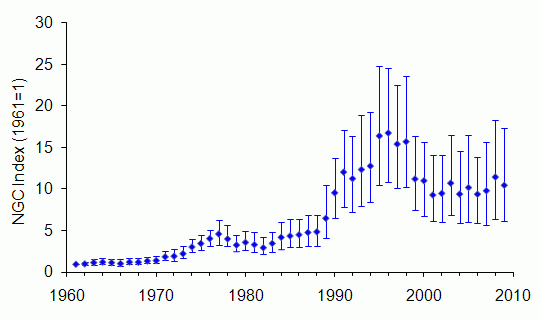
There has been a significant increase in the bag index between 1961 and 2009, rapidly so between 1989 and 1995. This represents a period of recovery from very low levels caused by myxomatosis. Since 1996 there has been an initial significant decline followed by stabilisation. The observed change may be linked to the spread of the new rabbit viral haemorrhagic disease.
Change in rabbit bags over time, with 95% confidence limits (see statistical methods):
| Country |
Sites |
Start
year |
End
year |
Change (%)
1961-2009 |
Change (%)
1984-2009 |
Change (%)
1995-2009 |
| United Kingdom |
1385 |
1961 |
2009 |
1046*
561 to 1831 |
109*
43 to 202 |
-24
-45 to 4 |
* significant at P < 0.05
England
Index of bag density from 1961 to 2009 (see statistical methods and interpretational considerations).
Error bars represent 95% confidence intervals.
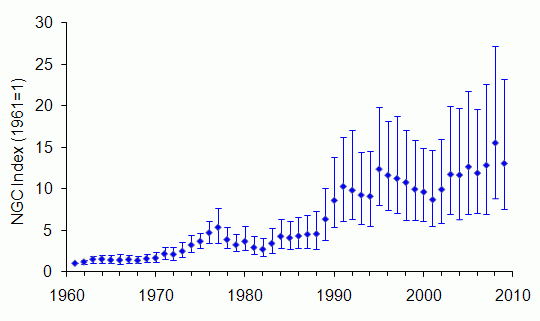
There has been a significant increase in the bag index between 1961 and 2009, rapidly so between 1989 and 1995. This represents a period of recovery from very low levels caused by myxomatosis. Since 1996 there has been an initial significant decline followed by stabilisation. The observed change may be linked to the spread of the new rabbit viral haemorrhagic disease.
Change in rabbit bags over time, with 95% confidence limits (see statistical methods):
| Country |
Sites |
Start
year |
End
year |
Change (%)
1961-2009 |
Change (%)
1984-2009 |
Change (%)
1995-2009 |
| England |
1016 |
1961 |
2009 |
1297*
725 to 2419 |
212*
110 to 321 |
39
0 to 81 |
* significant at P < 0.05
Scotland
Index of bag density from 1961 to 2009 (see statistical methods and interpretational considerations).
Error bars represent 95% confidence intervals.
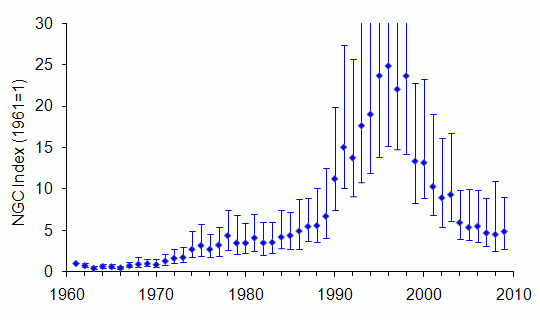
There has been a significant increase in the bag index between 1961 and 1996, rapidly so between 1990 and 1996. This represents a period of recovery from very low levels caused by myxomatosis. Since 1996 there has been a steep decline possibly linked to the new rabbit viral haemorrhagic disease.
Change in rabbit bags over time, with 95% confidence limits (see statistical methods):
| Country |
Sites |
Start
year |
End
year |
Change (%)
1961-2009 |
Change (%)
1984-2009 |
Change (%)
1995-2009 |
| Scotland |
306 |
1961 |
2009 |
436*
169 to 1330 |
-47*
-73 to -12 |
-85*
-92 to -74 |
* significant at P < 0.05
Wales
Index of bag density from 1961 to 2009 (see statistical methods and interpretational considerations).
Error bars represent 95% confidence intervals.
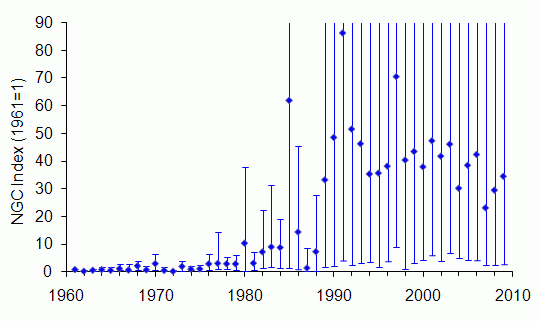
There has been a significant increase in the index of bag density between 1961 and 2009, rapidly so during the 1980s. This represents a period of recovery from very low levels caused by myxomatosis. The large confidence limits since 1985 are due to small annual sample sizes, and no trend is detectable from that point.
Change in rabbit bags over time, with 95% confidence limits (see statistical methods):
| Country |
Sites |
Start
year |
End
year |
Change (%)
1961-2009 |
Change (%)
1984-2009 |
Change (%)
1995-2009 |
| Wales |
45 |
1961 |
2009 |
3589*
221 to 18375 |
70
-27 to 914 |
-34
-74 to 264 |
* significant at P < 0.05
N Ireland
There are too few bag records of rabbit to produce an index graph. 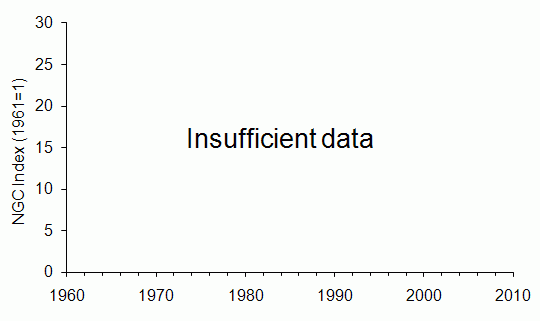
There are too few bag records of rabbit to evaluate rates of change over time
| Country |
Sites |
Start
year |
End
year |
Change (%)
1961-2009 |
Change (%)
1984-2009 |
Change (%)
1995-2009 |
| N Ireland |
Too few sites |
Environmental zones
Change in rabbit bags over time, with 95% confidence limits (see statistical methods):
| Environmental zone |
Sites |
Start
year |
End
year |
Change (%)
1961-2009 |
Change (%)
1984-2009 |
Change (%)
1995-2009 |
| Easterly lowlands (England/Wales) |
662 |
1961 |
2009 |
1430*
657 to 3067 |
164*
64 to 353 |
40
-7 to 110 |
| Westerly lowlands (England/Wales) |
270 |
1961 |
2009 |
507*
217 to 1461 |
131*
48 to 282 |
-20
-51 to 44 |
| Uplands (England/Wales) |
119 |
1961 |
2009 |
3254*
632 to 25108 |
448*
176 to 874 |
54
-6 to 180 |
| Lowlands (Scotland) |
102 |
1961 |
2009 |
1428*
148 to 7635 |
-1
-80 to 178 |
-76*
-94 to -36 |
| Intermediate uplands/islands (Scotland) |
56 |
1961 |
2009 |
97
-740 to 4230 |
-79
-126 to 100 |
-93*
-107 to -8 |
| True uplands (Scotland) |
152 |
1961 |
2009 |
343*
151 to 929 |
-49*
-75 to -12 |
-84*
-92 to -73 |
* significant at P < 0.05
Comparison with BBS mammal data
Since 1995, data on rabbit abundance have been collected under the Breeding Bird Survey (BBS) organised by the British Trust for Ornithology. Below, the UK trend from the NGC is compared to the one from the BBS (from 1995 onwards).
NGC index of bag density (blue) and BBS index of abundance (red), from 1995 to 2009.
Error bars represent 95% confidence intervals.
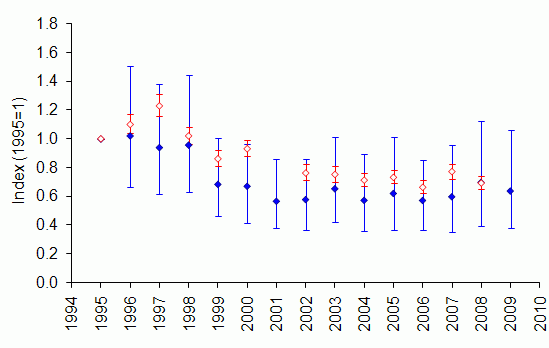
For all years, the BBS confidence intervals are completely or almost completely within the NGC confidence intervals, indicating good agreement between the two index series.
Long-term trend from the National Gamebag Census
Index of bag density from 1901 to 2009 (see statistical methods and interpretational considerations).
Error bars represent 95% confidence intervals.
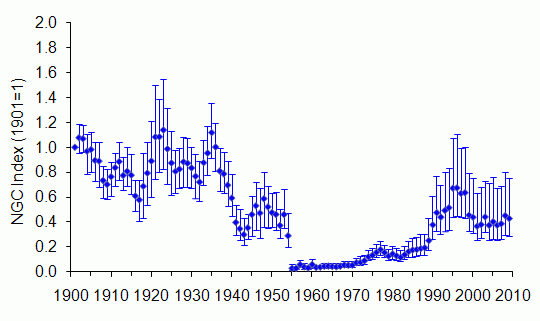
A cyclic trend persisted until the onset of the Second World War, then gave way to a marked decline until the 1950s. A crash in population numbers followed the advent of myxomatosis in 1953. There was only a partial recovery thereafter, to bag sizes roughly half of what they were at the beginning of the 20th century. For a more detailed interpretation of the long-term trend and its historical context, please click here.
References and further reading
- Battersby,J. (2005). UK Mammals: Species Status and Population Trends. Joint Nature Conservation Committee/Tracking Mammals Partnership, Peterborough (JNCC download page).
- Chasey,D. & Trout,R.C. (1995). Rabbit haemorrhagic disease in Britain. Mammalia 59: 599-603.
- Harris,S., Morris,P., Wray,S. & Yalden,D.W. (1995). A Review of British Mammals: Population Estimates and Conservation Status of British Mammals Other than Cetaceans. Joint Nature Conservation Committee, Peterborough (JNCC download page).
- Harris,S. & Yalden,D.W. (2008). Mammals of the British Isles: Handbook, 4th edition. Mammal Society, Southampton.
- McBride,A. (1988). Rabbits and Hares. Whittet Books, London.
- Ross,J. & Tittensor,A.M. (1986). Influence of myxomatosis in regulating rabbit numbers. Mammal Review 16: 163-168.
- Thompson,H.V. & King,C.M. (1994). The European Rabbit. Oxford Science Publications, Oxford.
This report should be cited as: Aebischer,N.J., Davey,P.D. & Kingdon,N.G. (2011). National Gamebag Census: Mammal Trends to 2009. Game & Wildlife Conservation Trust, Fordingbridge (http://www.gwct.org.uk/ngcmammals).
Return to species list
Get the Latest News & Advice
Join over 100,000 subscribers and stay updated on our latest advice, research, news and offers.
*You may change your mind any time. For more information, see our Privacy Policy.